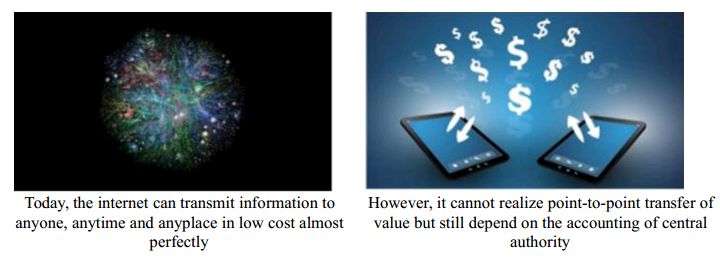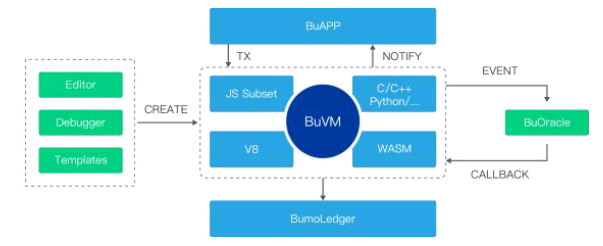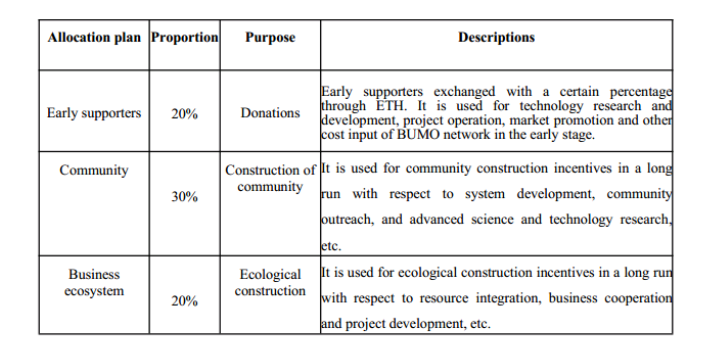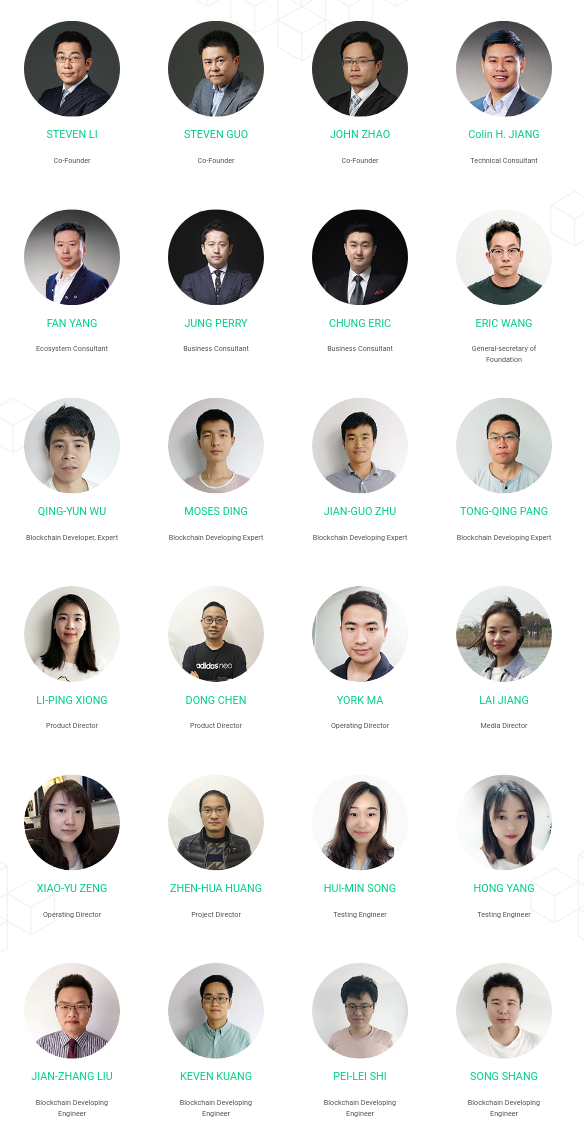1.1 Information and Value Transfer

The ease with which information can be transmitted within a short period of time and at a very low cost is made possible by the internet. The internet has made it very easy to the extent that the moment information is transfered, the sender and the receiver can have the information at the same time. However, P2P (Point to Point) value transfer and delivery has not been made possible compared to information transfer using the internet. Instead, a central authority is available to take on the accounting functions concerning the value transfer. Functions like, validating uniqueness of ownership and ownership record of transfer process.
1.2 Blockchains, its functions and Existing Problem.
Now, in order to solve this problem of centralization ( i.e to make value transfer and delivery possible without any central authority.), Blockchain is introduced.
Blockchain : Blockchain is very easy to understand, just see it as, "if platforms like HTTP and PROTOCOL serves as internet for information transfer, then BLOCKCHAIN serves as internet for value transfer" simple. In short, Blockchain creates a new generation of value internet which is totally decentralized (Does not depend on any central authority before it can provide a direct point-to-point value transfer)
Functions : Block chain is a technology which succeed in making transfer of values between two parties to be successful without the use of any intermediary (i.e central authority). Block chain uses computer networks on which records of transaction is made available in a public distributed ledger in the form called time blocks. This distributed Ledger at any time, can be accessed by any of the trading party, it is transparent and at the same time uneditable.
Existing Problems : Even though blockchain is successful in creating the internet of value and was able to acquire global attention and utilization, there are still some existing problems been faced by the Blockchain network[Problem of performance, Problem of energy consumption, Problem of Application threshold and Isolation of values. In order to solve the above mentioned problems, BUMO is introduced,but Before we discuss BUMO, Lets look at the bottlenecks of blockchain.
1. Problem of Performance : the quantity of transaction per unit time which can be controlled by the existing blockchain platforms in the name of bitcoin and Ethereum is very low. This transaction speed problem affect the performance of the blockchain.
2. Problem of Energy Consumption : For the existing blockchain represented by bitcoin, Miners undergo competition in order to solve an encrypted collision after which winners are awarded the next block accounting and other block awards. This mechanism leads to high computational power and centralization of mining.
3. Application Threshold : Presently on the existing blockchain, it is very difficult to develop business application due to the high technical and professional knowledge requirement during developmen of blockchain application.
4. Isolation of Values: On the currently existing blockchain, the circulation of digital economy and value system is totally closed. In addition to this, there is low or no liquidity for digital asset.
2.1 WHAT IS BUMO?
Bumo is a new breed of public chain created for businesses and which is capable of providing omnipresent(always available anywhere simultaneously ) trust network on which values can be transfered from one point to the other conveniently just like information. While meeting the needs of asset digitization and free flow of values (easy as the flow of information) withing various industries like, social network industries, Financial industries and internet of things, BUMO will place their focus on providing infrastructure for perfect value circulation network, BUMO will also make available for users, technical supports that is greatly accessible, resizable and perfectly efficient.
BUMO will make people (users) the real beneficiary of asset digitization simply by organically connecting digital asset, smart devices and users data.
2.2 WHY BUMO IS DIFFERENT FROM OTHER PUBLIC CHAINS
2.2.1. Bumo provides Ubiquitous trust network
The free circulation of value on Bumo is very authentic and effective because their trust network is based on machine which is made available everywhere simultaneously. Apart from the fact that decentralized value transfer and delivery is made possible by Blockchain network, all users of BUMO will be given the chance to be involved and to contribute to the building and construction of the blockchain network. What this mean is that; there will be interconnection, there will be universal contribution and involvement and also the decision making mechanism will be democratic in nature.
2.2.2. Secondly, Bumo establishes a value circulation system which is trustworthy
In other word, Bumo creates an authentic system of value circulation by making use of their ubiquitous trust network.
2.3 THE UBIQUITOUS TRUST NETWORK OF BUMO
2.3.1 Composition of BUMO Network
The good news is that, the BUMO network is not limited to any powerhouse computer to manage or run network nodes. Instead, BUMO is open and made available independently to any smart device in order to connect from the real world to the virtual world of blockchain. This implies that all smart device can act as node on the BUMO network.
The BUMO network is majorly composed of three parts as mentioned below;
1. Nodes : any smart device that is successfully connected to the BUMO network is represented as node. Each node is open and act independently within the network.
2. Candidate's Node :Candidate's node are the nodes that have the opportunity to undergo election/lottery in order to become validator nodes. All nodes possess the ability to apply for the candidate's node, but some number of qualified nodes are selected based on network scale and qualification requirement.
3. Validator Node : they are the elected candidate nodes. These nodes are endowed with the power to undertake the accounting function of the network, manage resources and they are rewarded with network transaction fees.
2.3.2. BUMO's Consensus mechanism

A new consensus algorithm(BU Firework) has been proposed by BUMO. This algorithm called "DPOS + PBFT" is capable of providing high rate of transaction, resizeablity and security in the BUMO network. Compared to the traditional Proof of stake (POS) and Practical Byzantine Fault
Tolerance (PBFT), the BU Firework algorithm will ensure dynamic election of validators on the BUMO network.
The links that made up the BU Firework Consensus Algorithm is listed below;
Link 1 : All nodes are capable of applying for contestant nodes but a number of qualify nodes is selected to undergo election/lottery to become validator nodes.
Link2 :all nodes on the BUMO network are given the ability to vote for the candidate nodes based on their right and interests. Each candidate will be given an amount of equity sum but the Highly voted candidate nodes will be elected to become validator node.
Link3 : Through the BFT algorithm, validator node decide and reach an agreement to complete the blocking validation. The higher the weight of validator nodes, the higher the opportunity of getting the cost.
Link4 :a validator node will be relieved of his accounting function(deposit managed) if by any means proven to be harmful(signing different blocks of the same height). This validator node will be removed from the set of validator nodes and then replaced by the equivalent contestant node.
Link 5 :in order to prevent the validator nodes from jointly creating a harmful attack system, there will be a point where all validating nodes is relieved of their accounting functions before redemption.
2.3.3 Incentive mechanism
In order for BUMO to quantify and characterize their economic activities, BUMO introduced the BU-token (represented by "BU"). When users initiate a transaction making use of the BUMO resources, there must be a kind of transaction fee, this fee is done by paying some amount of GAS which is measured by BU.
In order to determine the quantity and value of this GAS. The BUMO blockchain resources is classified into two;
1. Storage and network fee : the gas is quantified based on the transaction type and the required storage size.
2. Calculation fee :for the calculation fee, GAS is quantified by the weight of the required computing resources which is measured by the contract execution time. Based on the number of BU, it is the responsibility of the BUMO network to allocate time required to execute a smart contract. Therefore, a the number of BU takes a very long time for execution.
A. Gas allocation system
Since the validator node also participate in the BUMO blockchain network operation, some amount of GAS is also awarded to the validator node.
The formulae for calculating the allocation of Gas is as below;
Average cost = total cost / number of validators.
Remaining cost incentive = total cost - (average cost X number of validators)
B. Gas adjustment Logarithm.
Under the gas adjustment logarithm, participants in the BUMO network vote time to time in order to continuously change the reward allocated to the validator node.
Operations under Gas adjustment algirithm
- Registeration fee stardad
- Fee standard for Registeration cancellation
- Voting
- Withdrawal of vote.
2.3.4. Smart contract

Bumo's smart contract will be executed in an environment called BUMO Virtual Machine (BuVM). With the use of BuVM, users can now build high level application without any background knowledge for development. This has been made possible because BUMO smart contract will be developed using common development language such as Java script. In addition to this, BuVM will alsi come to reality based on the open source google chrome v8 engine.
1. There will be little or no cost of learning new programming languages for users since the development will be on JavaScript.
2. Smart contract will highly increase the efficiency of contract execution
3. Python, C/C++ and other programming languages through web assembly will be supported on BuVM
In order to coordinate with data in the real world outside the chain. Two methods will be provided by BuContract:
1. A contract of real data will be set up, this data will be paid for through a deposit, the data will be provided and maintained by the data privider. If by any means the validator or other participant of the community discover any form of Illicit action, then the deposit will be deducted.
2. The Bumo oracle machine will be notified by the contract the data to be obtained. This notification is achieved by a means of event triggering mechanism. After been processed by the oracle machine, the data must be returned back to the bumo virtual machine.
BuContract will also make available contract template which can be easily and quickly modified by the developers of various industry classification so as to quickly and safely realize contract functions.
2.4 BENEFITS OF BUMO
1.Bumo provides Free flow of digital assets : A static digital asset can be compared to a stagnant water, in the other hand a flowing assets will increase in value. With BUMO, digital assets will be flowing and circulating freely just like information and this will improve and provide new business values.
2. Intelligence IOT(Internet of things) value chain
- According to IDC prediction, the total number of IOT devices will reach 45billion unit by 2020.
- Better product and experiences will be created through data intelligence and value connection on the internet of things which is made up of 10 if billions of devices.
- Intelligent devices will create value so far they can generate data
- Uninterrupted trading of these data will be made possible by BUMO acting as universal digital book.
- IOT will also eradicate fragmented communication protocol standard.
- IOT will provide low cost of network maintenance
- IOT will improve security and build trust.
2.5 BUMO TOKEN
The digital economic activities on BUMO is quantified and measured using the BUMO token which is represented by "BU". The value of this token is mainly grouped into two :
1. In the use of BUMO network, some quantity of BU is consumed as the fuel for using BUMO.
2. If you are holding BU, then you have the chance to participate in the governance of BUMO community.
The distribution plan for Creation Generation BU is as follows:


Some Application scenarios of BU
1. Gas : when trade or smart contract is executed on the bumo network, Gas will be consumed.
2.Bookkeeping award : bumo's validator node receives reward on transaction in the form of BU.
3. Community incentives : in order to encourage and motivate community developers and other contributing users, bumo gives them BU
2.5.1 How to acquire BU
1. You can acquire gas as a validator node on transaction or contract execution.
2. BU can be transfered from one BUMO user to the other.
3. Acquire BU by exchanging with ETH when you participate in the early donation support project.
4. By participating in the building and construction of BUMO environment.
3.0 Use Case
A business enterprise is trying to set up their business in connection with the existing public chain. They got discouraged because of the high level of professional and technical knowledge required for the development of business app. Fortunately for this enterprise, they got to know that BUMO is another public chain that runs their business app development on Javascript and other simple programmes. In addition to this, BUMO will provide templates that can be easily edited. Now this enterprise is able to set up their business efectively and efficiently by making use of the BUMO network.
4.0 Bumo Team


Sponsored Writing Contest!
There is also a bonus CateredContent Event to earn additional Steem!
This post has been submitted for the @OriginalWorks You can also follow @contestbot to be notified of future contests!
Congratulations @ayobaba! You have completed the following achievement on the Steem blockchain and have been rewarded with new badge(s) :
Click on the badge to view your Board of Honor.
If you no longer want to receive notifications, reply to this comment with the word
STOPDo not miss the last post from @steemitboard: